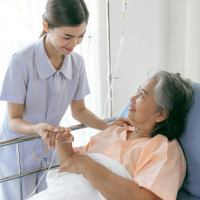
What was studied in this review?
Physical restraints (PR) are devices that prevent a person moving their body freely to a position of their choice. Examples are bedrails, belts and fixed tables, which prevent people from getting out of bed or a chair. PR use for older people who have dementia or who cannot walk well is used quite commonly when they are being looked after in care institutions or even in their own homes. The main reason given for using PR is to try to prevent accidental falls and fall-related injuries, or to prevent people from walking into other people's rooms or generally walking around unobserved and putting themselves or others at risk.
It is questioned that PR use is an effective way of preventing falls or fall-related injuries. In fact, by making people spend more time immobile, they may worsen walking problems and actually increase the risk of falling. They may also increase feelings of fear, anger and discomfort, and decrease well-being. Other unintended consequences include an increased risk of pressure ulcers and incontinence, and injuries directly related to the use of PR. In some countries, the use of PR is illegal in most circumstances and guidelines recommend that its use should be reduced or stopped.
What did we want to find out?
We wanted to know which interventions are most effective for preventing or reducing the use of PR for older people receiving long-term care either in care institutions or at home. Interventions for preventing and reducing the use of PR typically include education and training for nursing staff and may also include changes to policies and the way care is organised.
What did we do?
We updated a review that was last published in 2011. We searched for trials that investigated interventions intended to reduce or prevent the use of PR in older people receiving long-term care. The trials had to include a comparison group of people who did not get the intervention (a control group). We included eleven studies. All of them were conducted in long-term care facilities (residential and nursing homes). The average age of the people in the studies was about 85 years. In most studies, the intervention being tested was compared with treatment-as-usual although, in two studies, managers of nursing homes in the control group also received some additional information about PR.
Four studies tested organisational interventions, which aimed to change policy and practice so that nursing staff would use PR less often or not at all. An important part of these interventions was training 'champions' to support the rest of the staff in avoiding the use of PR. Six studies tested less complex interventions that offered education directly to nursing staff. One study provided nursing staff with specific assessments of the fall risk of individual residents.
What did we find?
Our main outcome of interest was the number of people who were restrained at least once during the period of the study. We found that organisational interventions probably lead to a reduction in the number of people restrained and a large reduction in the number of people restrained with a belt. One study reported whether the residents came to any harm during the study period and it reported no harmful events. We did not find any evidence that the interventions made a difference to the number of people with at least one fall or at least one fall-related injury, or the number of people prescribed medication to modify behaviour. These studies were mainly well conducted and reported.
For simple educational interventions, the quality of the studies and how well they were reported varied, and this affected our confidence in the results. The results of the studies were inconsistent, so we could not draw any conclusion about the effect of this type of intervention on the use of PR. None of these studies reported harmful events. Again, we did not find any evidence that the interventions made a difference to the number of people with at least one fall or at least one fall-related injury, and we could not be sure of the effect on prescription of medication.
Based on one study, informing nursing staff about residents' individual risk of falling may not lead to any reduction of PR use compared with the control group.
What is the conclusion?
Organisational interventions aimed at reducing use of PR through changing policy and practice in care homes are probably effective at reducing the number of people restrained overall and especially with belts. Reducing restraints did no lead to a higher number of people with falls. We are uncertain whether simple educational interventions reduce the use of PR, and interventions providing information about residents' fall risk may have little or no effect on the use of PR. All the evidence came from studies in institutions and it may not apply to care in people's own homes.
How up-to-date is this evidence?
The evidence is up-to-date to 4 August 2022.

